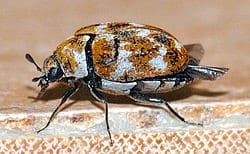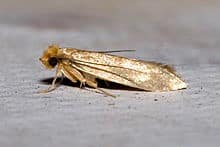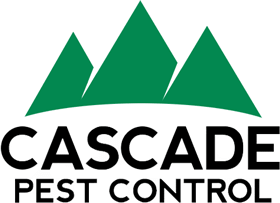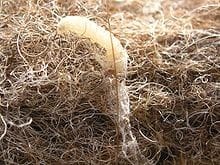Author: Kurt Treftz, Cascade Pest Control
Below we briefly identify and describe theses pests, and provide instructions on how to prepare for pest control treatment of carpet beetles or clothes moths.
Carpet Beetles
Carpet Beetles are abundant in the Seattle / Pacific Northwest regions and do most damage to clothing that we’d otherwise attribute to clothes moths. They originally gained their name by infesting wool carpets such that all the tufts would simply fall out, leaving the carpets backing-hence “thread-bare.”
 Carpet Beetles can be found in most Seattle / Pacific Northwest region homes and often people have no idea what is leaving small holes in their sweaters or suits. There are a number of carpet beetle species, but it’s the Varied Carpet Beetle—the one with a patchwork pattern of white, yellow and brownish splotches—that we have an abundance of.
Carpet Beetles can be found in most Seattle / Pacific Northwest region homes and often people have no idea what is leaving small holes in their sweaters or suits. There are a number of carpet beetle species, but it’s the Varied Carpet Beetle—the one with a patchwork pattern of white, yellow and brownish splotches—that we have an abundance of.
Carpet Beetles can thrive off shed pet hair, allowing them to multiply until they get into our woolens. Carpet Beetles are more adaptable than all that, however, and they are also formidable pests of stored foods such as spices and some grains.

Pest Control Treatment for Carpet Beetles is extensive so careful preparation is require by the homeowner.
Carpet Beetle Pest Control Treatment
Treatment—Carpet beetle pest control includes an initial treatment and periodic follow-up service.
Expectations—If a food source is located, the problem is more readily solved. In some cases, carpet beetle infestations are wide spread and control efforts must be persistent over time.
Warranty—We provide a re-treatment pest control warranty for carpet beetles provided that periodic service is maintained.
Preparation Instructions:
- People and pets must vacate during treatment and for 2 hours total. Prep work is to be completed prior to our arrival (the day before is best)
- Clean out all closets (floors, shelves, and hanging items).
- Pull out clothes drawers, emptying those with woolens, and stack them all facing the same direction.
- Make baseboards accessible—more small items, toys, etc. from base of walls. It is generally not no need to move large furniture.
- Clean underneath beds and leave clear for treatment, Vacuum under the bed.
- In kitchen: Empty cupboards and store items on kitchen table or within boxes on the floor, leaving cupboards and countertops clear. Check each food item removed for carpet beetle larvae as you go. Clean under the appliances (dishwasher, stove, refrigerator, trash compacter etc…)
- In the bathroom, prepare as kitchen clearing all cabinets and countertops.
- Vacuum all carpets, particularly along baseboards, paying attention to careful cleaning of any shed pet or human hair that may be present.
- In the utility room, clean under and behind the washer and dryer – the lint collection under these can be a breeding source.
- Vacuum floor registers or heat ducts.
- To help with prevention, store unused woolens and silks in garment bags, plastic bags that are sealed, or in enclosures with moth balls.
Clothes Moths

It is the larvae of clothes moths that cause damage. Clothes moths are known to consume cotton, linen, silk and wool fabrics as well as furs. They will also eat synthetic fibers if they are blended with wool. Once they change into the moth stage they can fly, mate, and lay eggs.
Pest Control Treatment for Clothes Moths is extensive, so careful preparation is required by the homeowner.
Clothes Moth Pest Control Treatment:
Treatment—is a 2X pest control treatment, spaced about a month apart. Second treatment is scheduled at the time of initial service.
Warranty—begins 30 days from date of second pest control treatment provided proper preparations were performed in advance by homeowner.
Preparation Instructions:
- People and pets must vacate during treatment and for 2 hours total.
- House preparation (must be complete before technician arrives).
- Clean out all closets (floors & shelves cleared, hanging items removed).
- Pull out clothes drawers, emptying those with woolens, and stack them all on floor, arranged such that they are all facing the same direction.
- Make baseboards accessible—move small items, toys, etc. It is not required to move large furniture.
- Clean out beneath beds—clear items out and vacuum.
- Vacuum all carpets and baseboard areas, paying particular attention to carefully cleaning any shed pet or human hair that may be present.
- Homeowners can help avoid re-infestation by storing unused woolens in garment bags, plastic bags that are sealed, or in enclosures with moth balls
- If an area rug appears to be infested, you may need to have it professionally dry cleaned, consult with your Cascade technician.
Professional Pest Control for Carpet Beetles & Clothes Moths
Do you have a moth or beetle problem in your home or business? Pest control for carpet beetles or clothes moths is involved and requires preparation and professional pest control treatment. Contact Cascade Pest Control for professional pest identification, extermination, and ongoing pest control services:
Call or Request a Quote Online:
Seattle Region: 1-888-989-8979

